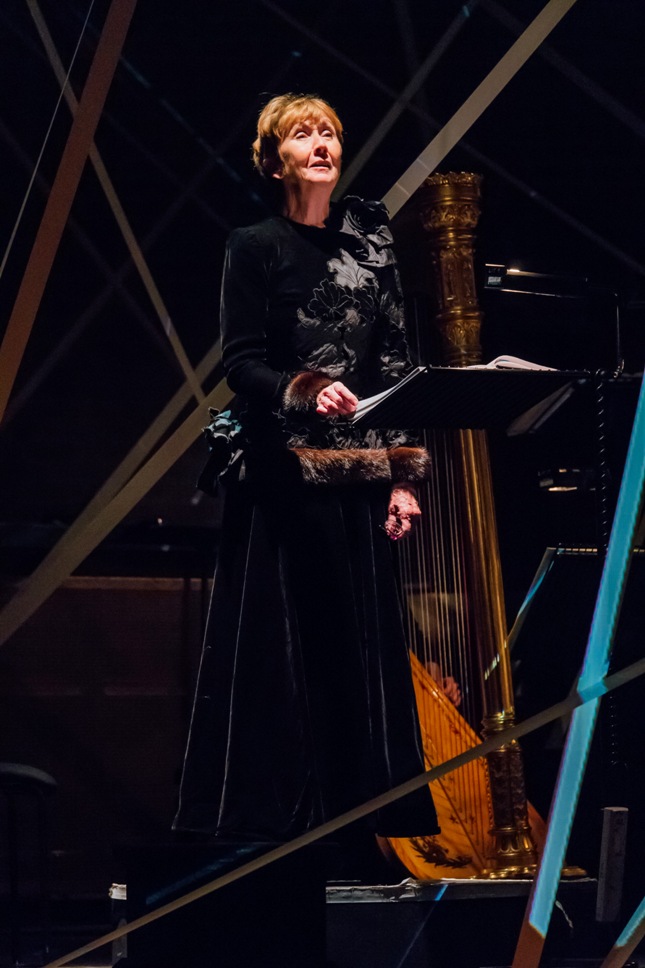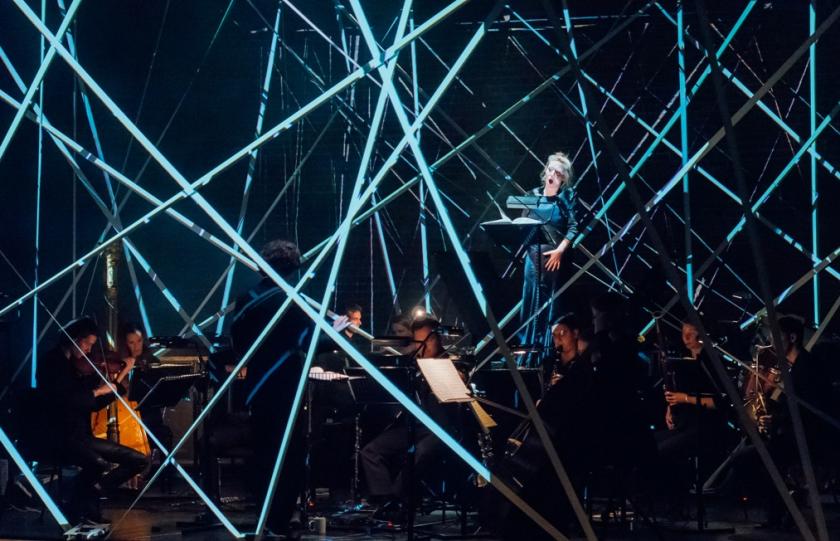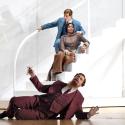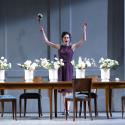A Hawksmoor church ought to be the right setting for the psychological terror of Britten’s great chamber opera, a slanted but still chilling adaptation of Henry James's novella. True, the once-deroofed interior has been coolly revamped as a rehearsal and performance venue, but imaginative lighting and a clear acting space, with room for a 13-piece ensemble to the side, ought to do the trick.
Unfortunately this setting, straight from Aldeburgh, isn’t exactly that for what its "conceivers" describe as “not a conventionally staged production… not ‘semi-staged’, nor… a concert performance”. It’s static and hems in the imagination rather than letting it flow as power play between the characters shifts, or ought to.
The latticed cube within which most of the performers exist refers both to the child Flora’s cat’s cradle and to the labyrinth in which the protagonist finds herself lost at the beginning of the second act. It's the work of those “conceivers”, Sophie Hunter, Andrew Staples – the most imaginative of tenors, too, singing ghost Quint and the Prologue here – and William Reynolds. The concept has been executed, and brilliantly, by La Fura dels Baus’s Valentina Carrasco in Lyon. But that was dynamic, catching up objects as well as people as the screw turned. Here, while the ghosts first appear, and the children go through rituals, outside the cube, four of the perfomers are stuck rigidly, for most of what they sing, in fixed places behind music stands. The beyond doesn't make for effective glimpses of "the others" before they sing - a glaring light obscured the figures, and since St Luke's makeover has spiral staircases, why not have Quint in a tower as specified rather than on the ground?
 Using scores was the biggest mistake. Sophie Bevan, convincing in every word and every colour as the mind-besieged Governess, certainly didn’t need one; Ann Murray (pictured right), still inflecting with an intelligence and subtlety that suggests housekeeper Mrs Grose understands more than she says, knows her role well. Both ghosts, Staples and Jane Irwin as the former governess complicit in his nameless malignity, projected some wonderful sounds but weren’t note or rhythm perfect last night. Perhaps there hadn't been enough rehearsal time to embed Britten’s superb speech melodies sufficiently deep in their consciousness. And if I say I could sing you the Prologue note for note, that’s not to boast but to point out that like Cole Porter, Janáček or Sullivan setting Gilbert, Britten sets the words so memorably that they embed themselves in the psyche very quickly.
Using scores was the biggest mistake. Sophie Bevan, convincing in every word and every colour as the mind-besieged Governess, certainly didn’t need one; Ann Murray (pictured right), still inflecting with an intelligence and subtlety that suggests housekeeper Mrs Grose understands more than she says, knows her role well. Both ghosts, Staples and Jane Irwin as the former governess complicit in his nameless malignity, projected some wonderful sounds but weren’t note or rhythm perfect last night. Perhaps there hadn't been enough rehearsal time to embed Britten’s superb speech melodies sufficiently deep in their consciousness. And if I say I could sing you the Prologue note for note, that’s not to boast but to point out that like Cole Porter, Janáček or Sullivan setting Gilbert, Britten sets the words so memorably that they embed themselves in the psyche very quickly.
Bevan convinced us of that, capable of soft and melting tones as well as pure white notes but opening up to scary forcefulness from the point at which the Governess jumps to conclusions about what has been happening to the orphan children at Bly and makes her fatal resolve to protect them at any cost. Every phrase has meaning, every top note rings out with that bloom which saw her Sophie stealing the show in Der Rosenkavalier both at ENO and in Birmingham.
Unfortunately Bevan's positioning, the furthest back behind the orchestra, excluded both any ambiguity about whether her imagination is running havoc and the ghosts do exist, and any sense of her coming unwholesomely closer and closer, like Quint, to her charge Miles. Something’s wrong when in the bedroom scene Staples’ seducer hovers above the boy while the Governess is stuck at her post way behind (pictured below, Staples and a distant Bevan).
 The children, Joshua Kenney and a girl rather than a developed soprano, Louise Moseley, as Flora, were scoreless – young Joshua could have done with the prompt in the crucial final scene last night – but musically spot-on, even if this Miles is the kind of cipher on which you project your own imagination. Their rituals are sometimes perceptive, as in the initial reversal of the sexes in their bowing and curtseying, but more often constricting; this concept, like the ghosts and the Governess, never lets them just be normal children.
The children, Joshua Kenney and a girl rather than a developed soprano, Louise Moseley, as Flora, were scoreless – young Joshua could have done with the prompt in the crucial final scene last night – but musically spot-on, even if this Miles is the kind of cipher on which you project your own imagination. Their rituals are sometimes perceptive, as in the initial reversal of the sexes in their bowing and curtseying, but more often constricting; this concept, like the ghosts and the Governess, never lets them just be normal children.
Having the players at the front of the cube allows countless miracles of orchestration to make an even greater mark than usual – the sombre string clashes and high-cello weirdness, the unusual threatening quality of the celesta played by John Reid, whose pianism is astoundingly vivid, the amazing harp writing exquisitely taken by Sally Pryce. But total clarity also means a lack of mystery, and though Nicholas Collon, after a disappointing Glyndebourne-on-Tour Rape of Lucretia, is pitch- and pace-perfect, my flesh crept only when all the voices combined in a sensuous orgy at the end of Act One and at Bevan’s desperation. With her sister Mary hopefully recovering her voice over at the Sam Wanamaker Playhouse, and Louise Alder in that same Orpheus clearly the next in lyric line, we're so lucky with our home-grown sopranos at the moment.















Add comment